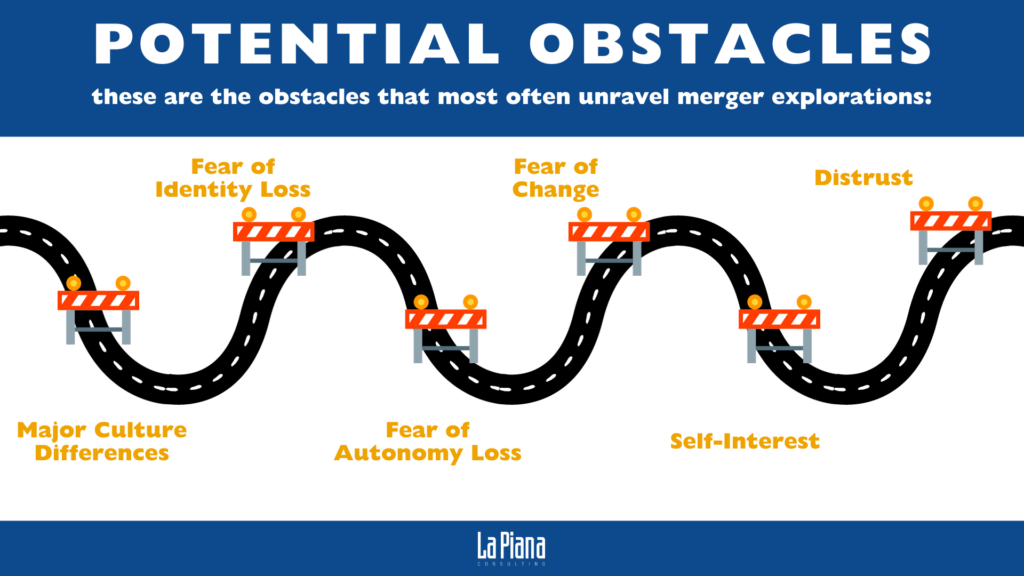The Human Side of Mergers: Nurturing Trust and Overcoming Resistance
Staff are vital to merger success, but initially might not be happy about the merger. Leaders can do some key things to get in front of merger anxieties and help staff become more comfortable with change.
When two or more organizations decide to form an integrated partnership, there is a long list of things that need to get done to ensure success. These might include filing the required forms with the Secretary of State’s office, updating the bylaws, transferring staff, integrating budgets, training staff on new systems, merging technologies, and the list goes on. Many people involved will want to focus on these details, processes, and costs, especially if they fully support the partnership and see the potential mission impact early on. It’s not that these things aren’t important or that they don’t need attention from board and staff leaders, but while working on these issues staff concerns can bubble up under the surface. These concerns might seem minor compared to the other integration work, but if ignored they can dissolve a budding partnership or make a successful integration feel impossible. Slowing down and helping people move forward can make all the difference.

Much can be done about these individual obstacles during negotiations. For example, maintaining the legacy of a dissolving organization can mean a lot to the board of that organization, and it might be as easy as maintaining a program name post-merger. During merger negotiations it is also vital to leave space for creating a shared vision and building trust across the combined organization.
Looking closer at these potential obstacles, however, it becomes clear that the bigger issues that will require ongoing intentionality are the cultural differences and the lack of trust. These usually can’t be addressed in a single meeting or with a single concession during negotiations, and they can be especially challenging for the folks who were not in the room for negotiations or consulted before a decision was made to merge. If these challenges continue to impact the staff as the organization works to integrate, it can create ongoing fissures that may continue to grow.
How to address:
Preparation for a merger starts many months in advance of a board vote, and might include a Culture & Partnership Assessment Survey. Assessment and conversations about shared vision and motivations can be instrumental in getting to negotiations. Following explorations and negotiations, the boards may vote to merge! As much as you would like to celebrate the decision to formally merger and then get to work, some staff just may not be excited about what constitutes a major change. Here are some tools to support the resisters and shift the culture.
Communicate, communicate, communicate! Make it clear what you are solving for with the merger and how the change will positively impact the organization, the field, and the community you serve. This all may be obvious to you, but others may not be as visionary or strategic, and not everyone has the same viewpoint on the organization. People are often siloed and focused on their department or the services they provide. Make time to plan for and have intentional conversations about where the organization is headed and what people can expect.
Be visible and public in your support of the partnership. At every opportunity — in discussions with board members, community members, clients, funders, and staff — talk about the benefits of the merger. Share successes as they happen and talk about how plans for the future will allow for streamlined services, more efficient operations, or deeper mission impact. After hearing this often, it will become more apparent for people, and they will naturally connect the partnership to improved impact.
Find and empower champions on the staff and board. The board chair or Executive Director can’t be the only ones who believe in the vision and potential impact of the merger. There are others who can be empowered to be change makers in the organization, talk positively about the merger, and remind others of how the merger can improve impact. This will take intentionality. Think about who is best to play this role and talk to them about tactics they can use in conversations with fellow board, staff, and stakeholders. It can help to provide talking points including successes and goals that champions and board members can use during these conversations.
Acknowledge that change is hard. As a leader with a vision and compelling reason for pursuing a partnership, you should absolutely share that with the world. That said, you need to remember that as things change, those closest to the work may be challenged by the unknown and fearful of what might be lost as a result. You should also find ways to talk openly about all that is changing and the anxiety that comes along with it. As things change, some programs, systems, and practices may need to change or may end completely. Make space to talk about those things and acknowledge those impacted. These conversations should not undermine excitement about the future, but without acknowledging the challenges, resentment and resistance can build.
Create new norms and traditions together. Even if your merger brings together organizations of different sizes, you are still building something new together. This is an opportunity to build a positive culture and tie it to the new and improved organization. Identifying and maintaining what has worked well is fine, but it’s also important to make space for new practices that can equally involve members from all legacy organizations. This might include planning ceremonial endings for programs or traditions that will not continue, and then celebrating new practices the merged entity undertakes. It can often help to form a Culture Committee to lead these efforts. Creating this Committee can be a great opportunity to bring people together from the legacy organizations and across departments, and will likely help to build champions within the organization as well.
In Summary
When facilitating a merger, executive staff often tell me that the process will be easy because the reasons for merging are obvious. That may be true for them, but others might have more difficulty moving on from the current state. At the end of the day, change is still hard, even if it is for the best. It’s possible some staff and board members will decide to leave. And that’s OK. This can make space for new and diverse perspectives and skills, ultimately strengthening the organization. That said, you don’t want to lose people who are important to the future of the organization just because they were not given the space and support to embrace a major change. Being aware of cultural differences and taking the time to address feelings of uncertainty can help alleviate the consequences of these merger pitfalls.
Considering a merger, alliance, or some other form of collaboration? Our Merger & Alliance Toolkit provides practical information and concrete guidance to help you move forward. If you’d like to speak with one of our consultants, you can reach us at info@lapiana.org.


Comment section